
In this class, I covered three separate topics: a tool you can use to brainstorm ideas, fun with commas, and another tool to help you post in markdown. The content below is taken from the Dynamic Steemians Discord chat session on Thursday, April 12. I edited it for clarity and content before posting.
Finding topics to write about
One the of the top issues many people have on Steemit is finding topics to write about.
The basic technique is called mind mapping. It's where you put down a topic, idea or phrase and then brainstorm topics that are related to it. You can do it using pen and paper, or post-it notes, but my favorite way is using a program called SimpleMind.
It's a cross-platform program, so it works on mobile, Windows and Mac devices.
To show what I'm talking about, I'll share some examples.
Using SimpleMind
For those of you who don't know, I'm a physicist and tech geek as well as a writer. I have lots of freelancer friends who are always asking about tips and tools they can use in their business (I'm the go-to geek) because I can usually talk about it in terms anyone can understand. That's my goal anyway.
So I started a project to write a book about the different types of technologies freelancers can use and why they'd want to use them. This first screenshot is one of the first mindmaps I made for the project using SimpleMind.
I use the program on my iPad, and it is very intuitive and easy to use. You'll have to click on the image to see the details and how it works. The central oval has my original thought: "Technology helps freelancers." Branching off from that are all the ways it helps them that I could think of when working on this. The colors don't represent anything in particular, other than they are different branches. The program lets you pick a color theme, and it applies it automatically (you can manually make adjustments too). So while there's a bit going on in this mindmap, you'll see it's pretty simple compared to the next one.
This mind map has a central idea of "Types of Technology," and all the branches are the different types I could think of. Then there are branches down from those to examples of each kind of technology or resource.
For example, I have "Productivity tools" as one type of technology. Then I have three sub-types branching off from that: time trackers, focus tools, and research tools. Beneath each of those, I put particular programs or techniques that fall into the category.
It's a much more visual relationship than just a list like I made in the previous paragraph. And if I decide one category belongs in another, I can just move it. And I can go as many levels deep as I want. I even get specific with particular programs and also included notes to myself if I knew I had more information in other places - but was too lazy to go look them up while doing creating this version of the mind map.
When I thought I had completed the mindmap, I exported it as an outline, and that is what I'm using to write my book. The bulk of it anyway. I had to add the usual introduction, endnotes, forward and all that too after I exported. Hopefully, you can see that using this technique lets you be free with your thoughts and it helps you find associations between ideas and topics.
I'm sure there is some science to back up why this method works. But for me, I can tell you it works. Especially if you have lots of ideas and don't know where to start, using this helps you put them down in some order. And if you don't like that order? Then it's easy to move the ovals around and make it look different.
As I'm writing this, I realize I can't communicate how easy this is to do because those pictures look kind of complicated. So I'll put together a short video on the topic to post on Steemit. Even the promo videos on the site I don't think get the point across to someone who hasn't done it before.
And that reminds me, here is the link to the website: https://simplemind.eu/ SimpleMind Home - SimpleMind
How you can use SimpleMind
So how to use it for writing your blogs?
Start by putting something you know about in the center.
Let's say you know all about horses. Put horses in the middle. Then you add subtopics that come to your mind about horses - riding horses, care of horses, types of horses, etc. (I don't know about horses so that's about as far as I'd get).
Then underneath each of those you add the specifics of what comes to mind - riding horses might have topics of saddles, reigns, gaits, trails, tips, etc.
So in the process, you take what was one topic you knew about and maybe one blog, and it then becomes 5, or 10, or 20 or more depending on how deep your knowledge and interest is.
When you are stumped for ideas, you just go back to your mindmap and see what's there.
And that is one thing I really like about doing this electronically on a tablet is that you'll always have it (barring some horrible, disastrous destruction of your tablet and you had no backup. HINT: Always make a backup!).
You can return to it, add things, move things around, and use it to guide your writing topics. It's like a living editorial calendar only much more accessible than a spreadsheet - at least I think so!
And I harp a little on the tablet part because I can't stand using the software on a laptop or PC. There is something for me in the mind-to-finger connection that isn't there when I'm using the mouse to move things. But it might work just fine for you.
The program has a free/trial version so you can see if it's something you like. There are other programs that do the same thing. Another popular one is Xmind, but when I last used it, there wasn't a tablet version. There is an app for iOS now, but not Android. But the Xmind Pro desktop version is $129! There is also a subscription plan.
SimpleMind, as of this writing, is about $30 US for a PC and only about $8 for a tablet. There are no other fees, just the outright purchase price. Plus there is a forever-free version with limited features, but that might be enough for you. Try it and find out!
The details matter: comma usage
The next topic is one that I absolutely dread: Grammar.
(Can you hear the screechy horror music playing in the background?)
And to be honest, I am not qualified to teach grammar at any level. I haven't had a formal grammar class since 8th grade - and that's a loooong time ago.
But as a writer, I've had to learn it. Well, learn it better than I did in school back then.
As a copywriter, I have to know the rules of it, so I know when it's ok to break them. If I don't, it will look like I, or whoever I've written for, is uneducated.
So I'm sharing some examples of why you need to understand it, but I'm only going to cover comma usage. At least right now. Because as you'll see in the following examples, a comma can make a HUGE difference.
Here we go. Let's have some fun!
Example 1.

Source
At least you don't have to run fast from the children and animal zombies. Or it could be that they are all just dead slow, as in sloth-like. Who knows?
I'm still confused why the word DEAD is in this sign at all. I've heard of a dead end road, but never just a dead one.
However, if you put a comma after slow, you'd have DEAD SLOW, CHILDREN ANIMALS. With that, you'd be communicating the need to go slow, very slow, dead slow in fact. But then you're left with "CHILDREN ANIMALS" which on the surface isn't much better.
Next...
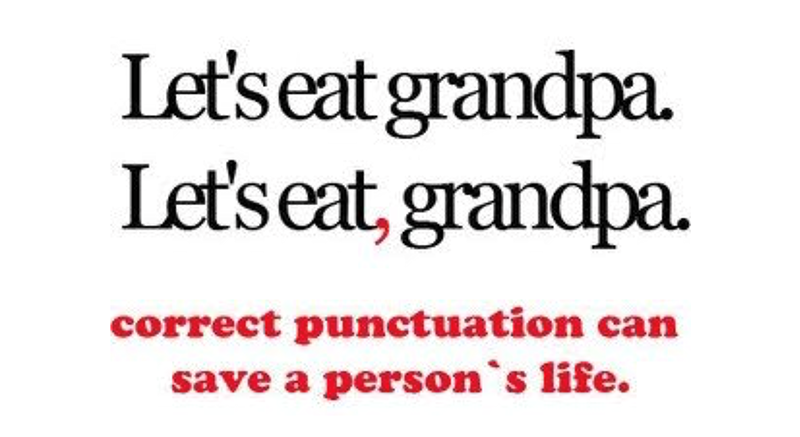
Source
Poor Grandpa. This example makes the importance of the comma pretty clear. No one wants to eat Granpa, or have the problem the poor sap in this next picture has:
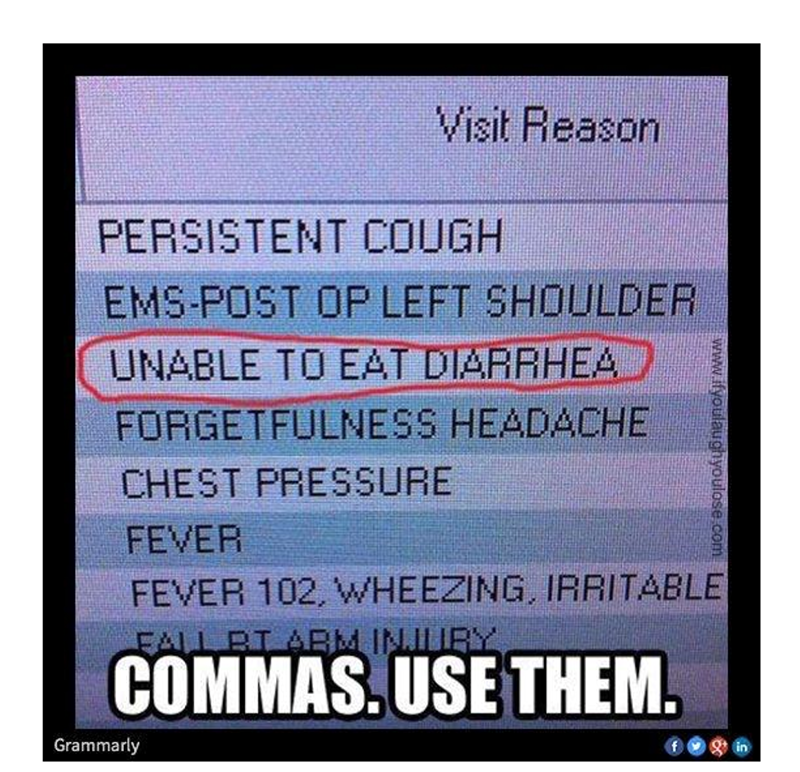
Source
That one is, ah, hard to swallow! Obviously, the patient is being seen because he can't eat, and he has diarrhea, but without the comma, he's there for a whole other reason....
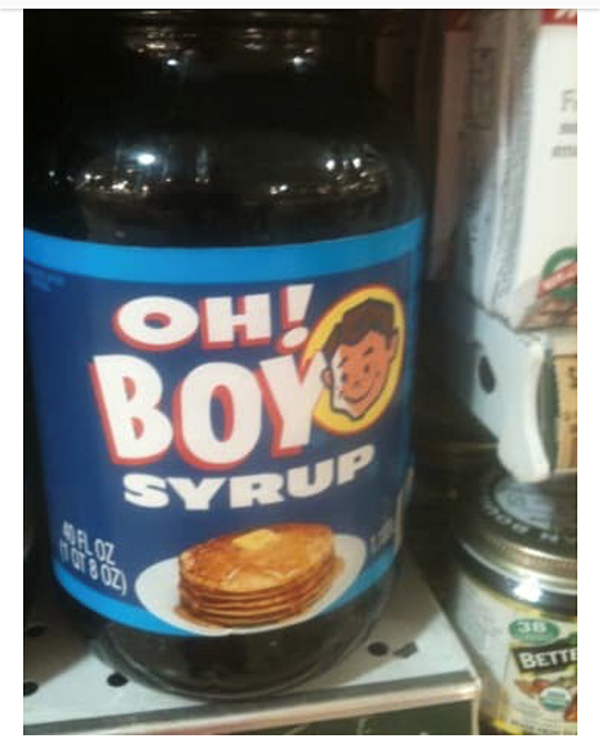
Source
Boy syrup anyone? Made from real boys I hear. No? Didn't think so.
You know what the marketer thought when they designed this, but someone really should have said something. The proper phrase is "Oh, boy!" So they not only missed the comma but also placed the exclamation point in the wrong spot.
Here's a good cartoon that also makes the point
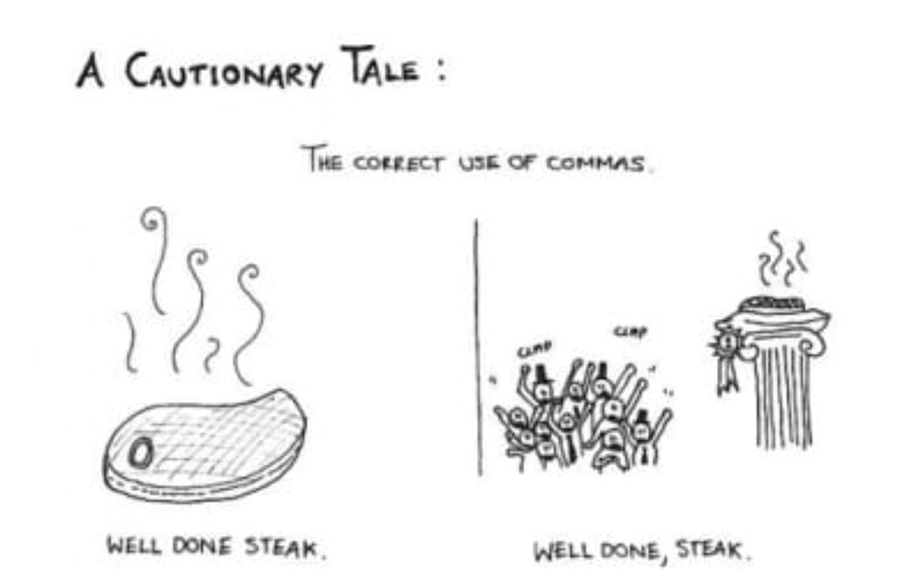
Source
A small space does not excuse you from comma usage as you'll see in this next example.
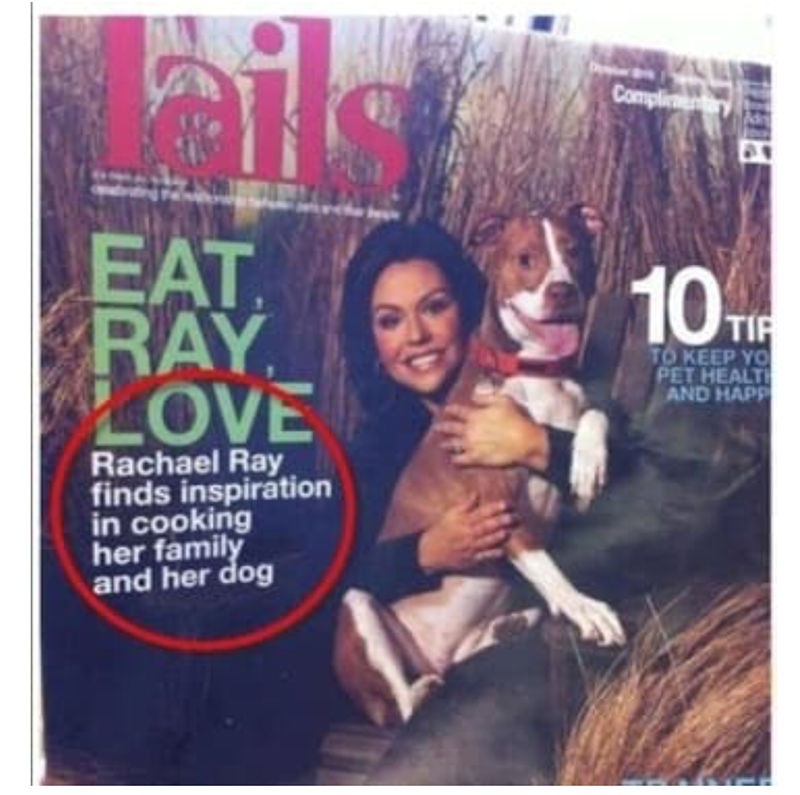
Source
I wonder whether she cooks them together, or as separate dishes? My daughter said she thought the dog was looking a little nervous.... A comma after "cooking" would have saved many readers from the horror of this cover.
Even well-meaning people can cause confusion when they leave out the commas:
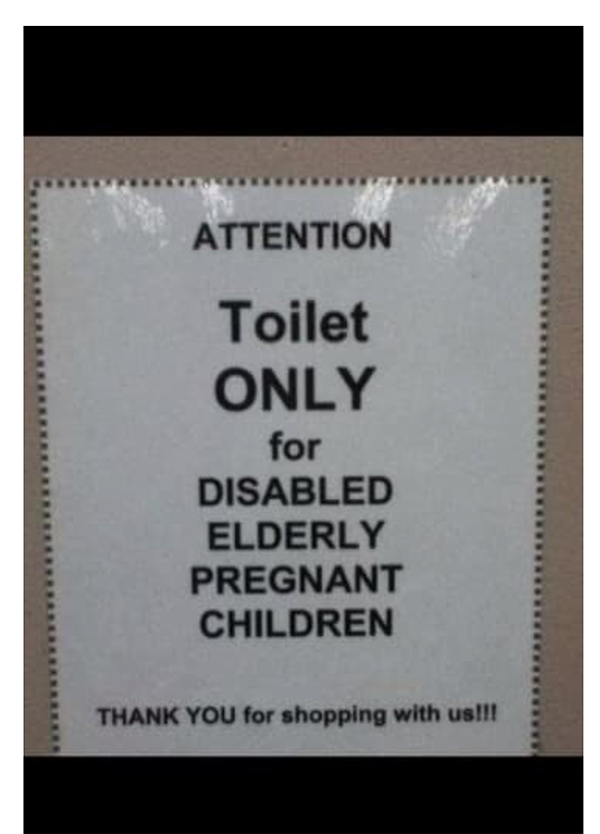
Source
Have you ever met a disabled, elderly, pregnant child? Me neither. I think though that to make it perfectly clear, they also should have a colon after the "for" and commas between the items on that list. But hey, it's a bathroom stall sign so who wants to be picky?
And this last one I included because I'm pretty sure someone meant to use a comma but put in a period instead. Still, it has a catastrophic effect on the content.
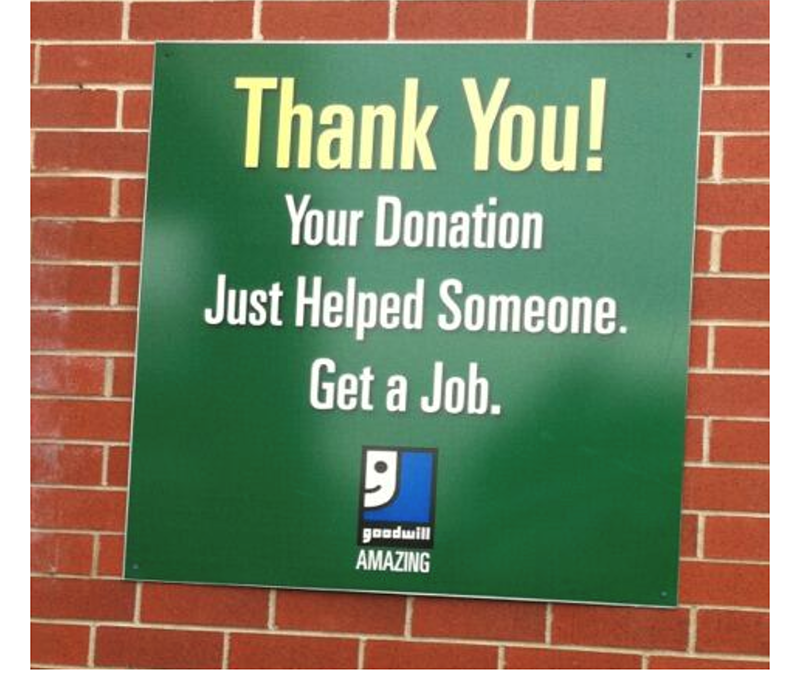
Source
How ungrateful can you be?
The correct version of this one shouldn't include any punctuation except for the final period, "Your Donation Just Helped Someone Get a Job."
I hope you got a chuckle out of some of these at least.
If you did, you should check out this compiled list by Buzzfeed. It has many other ones that are hilarious, but not necessarily family friendly if you care about that sort of thing.
Learn more and have fun
If you want to learn more about how punctuation can make a difference in your writing, I recommend reading Lynne Truss' Eats, Shoots & Leaves.
I mentioned I hadn't formally learned grammar in many years, but I didn't mention my disdain for it. All those long, complicated words like "dangle participle" never meant anything to me and I resented them playing any part in my writing at all points in my life.
But this book changed that, at least removed most of my disdain. It's the ONLY grammar book I will ever read because it's absolutely hilarious. I'm going to share a couple of excerpts with you to convince you it is worth your time to check it out.
In the introduction, the author talks about a banner she saw outside a local petrol station (that's a gas station to those of us in the US). It included the word "Book's," when referring to multiple books. She goes on to describe what happened when she read it.
"For any true stickler, you see, the sight of the plural word "Book's" with an apostrophe in it will trigger a ghastly private emotional process similar to the stages of bereavement, though greatly accelerated. First there is shock. Within seconds, shock gives way to disbelief, disbelief to pain, and pain to anger. Finally (and this is where the analogy breaks down), anger gives way to a righteous urge to perpetrate an act of criminal damage with the aid of a permanent marker."
Even if you aren't a grammar nerd you'll see the humor in that I hope. The poor lady was driven to near madness by a simple misuse of an apostrophe. Later, in the chapter on apostrophes, she talks about a music band that had the name Hear'Say. They became quite popular where she lived, and she cringed every time she saw the name. Here's what she said about it,
"Now, there are no laws against imprisoning apostrophes and making them look daft. Cruelty to punctuation is quite unlegislated..."
To her, punctuation is deserving of basic human rights. The entire book is written in this way, and it's a fun read. It's also educational for anyone who wants to write and be understood. I'm the first to admit I don't follow "correct" usage for commas, and abuse them regularly - as Truss would say. Most of the time it's intentional, but when it's not Grammarly usually lets me know.
If you don't want to, or don't have time to read the book, here's a link to some rules on the most common English punctuation marks. http://www.enchantedlearning.com/grammar/punctuation/
I recommend mastering the comma, with the assumption you already know how to use a period.
Feel free to ignore semicolons. They have a purpose, but if you technically need to use one based on grammar rules, then you need to rewrite your sentence. Especially when blogging. You want the reader to keep reading and flow through your words. A semicolon is so infrequently used that it stops the reader. Most don't know what it means or why it is there. So take whatever you've written and make it two distinct sentences or one, more focused, sentence.
And that ends my commentary on commas.
A tool for writing in Markdown
The last thing I have is much more practical: Writing your blogs in markdown.
I found markdown pretty easy to pick up when I started on steemit. I did have to refer to the cheat sheet for links and lists for quite a while though.
But I had a problem that many of you probably do too. I'd spend hours writing my blog, and then another hour or two formatting it correctly in the Steemit post editor.
The first few writing classes I tried to get the summary posted the same day as the class by writing it up and publishing before 12 am my time (class ends at 10 pm). But both times I tried that, I didn't finish the editing until after 12. And a lot of that was because of trying to do the markdown. I looked around thinking there must be an easier way.
There are many downloadable markdown editors, but I make it a rule not to download anything I'm not 100% sure is from a safe site and is free of malware/viruses. Most of the editors I found didn't meet that criterion. But then I came across one called StackEdit.
It's a browser-based editor that works very similarly to a word processor. If you want to bold some text, you just highlight it and click the big B on the toolbar. You don't need to remember to put two ** before and after the word. It's much simpler.
Here's a screenshot of the summary from last class that I wrote in it.
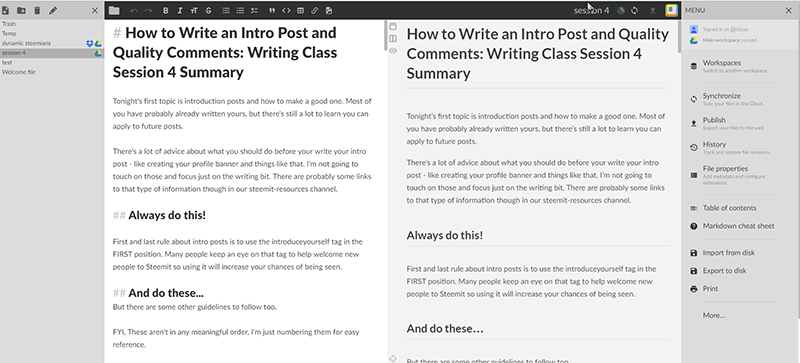
On the far left is the file navigation/creation options. The white panel on the left is the editing window where you enter your text and do the formatting. The white panel on the right is the preview of the Markdown. The rightmost column is a list of options for saving, exporting, and a Markdown cheat sheet in case you need something that isn't listed.
So while you can see the # marks on the markdown side, I didn't type those. The button on the menu with two "T"s toggles between H1 and H2 tags. If you want H3, H4 or smaller headlines you will need to enter the right number of hashtags.

In this pic, you can see I have a list. Again, I didn't need to remember how to make a list. I just clicked on the bullet list icon at the top.
You get the idea right? Instead of having to remember the right syntax and then taking the time to manually enter it all you just format it like any other word processor. And you can see what it looks like in the right-hand panel.

It works for links too, which I find the most time-consuming things to do in markdown. On the left, you can see where I hyperlinked "SteemPlus" and on the right, you can see how it highlights the text with the link. It's the same for the embedded image. You can see the link for the image posted there.
I created the link using the "link" button and inserted the image using the media button at the top. The media does require a URL. The only thing I've found it doesn't do well is to create a linked image. To do this I have to insert the image using the button, then edit the image link with the right syntax to make it a clickable link.
There may be a way to do this using the editor tools, but I haven't found it. There isn't that much in the way of a help file either. What you do get is the "Welcome file" that is there when you first start using it. That gives you some basic instructions. Most of the tutorials I found on the web focused on how to synchronize your work with Google Drive or Dropbox.
When I get a few moments, I might tackle a basic tutorial video. We'll see.
Anyway, Stackedit allows me to compose and format my post at the same time. All I had to do was copy and paste the markdown into the Steemit editor. It was seamless. And it saves me at least an hour, if not more.
Here is the link if you want to try it out. https://stackedit.io/
Did I mention it's entirely free and open source?
Also, it will connect to Dropbox, or Google drive or many other storage options so you can keep a copy of what you are working on.


If you have any questions about this content, please let me know in the comments. Or better yet, click the banner to join my channel on Dynamic Steemians' Discord!

Remember you can post any question at any time. You don't need to wait for a live session.
Note: All images are mine or licensed from Adobe except where noted. The Dynamic Steemians' banner was thoughtfully provided by @baa.steemit.
